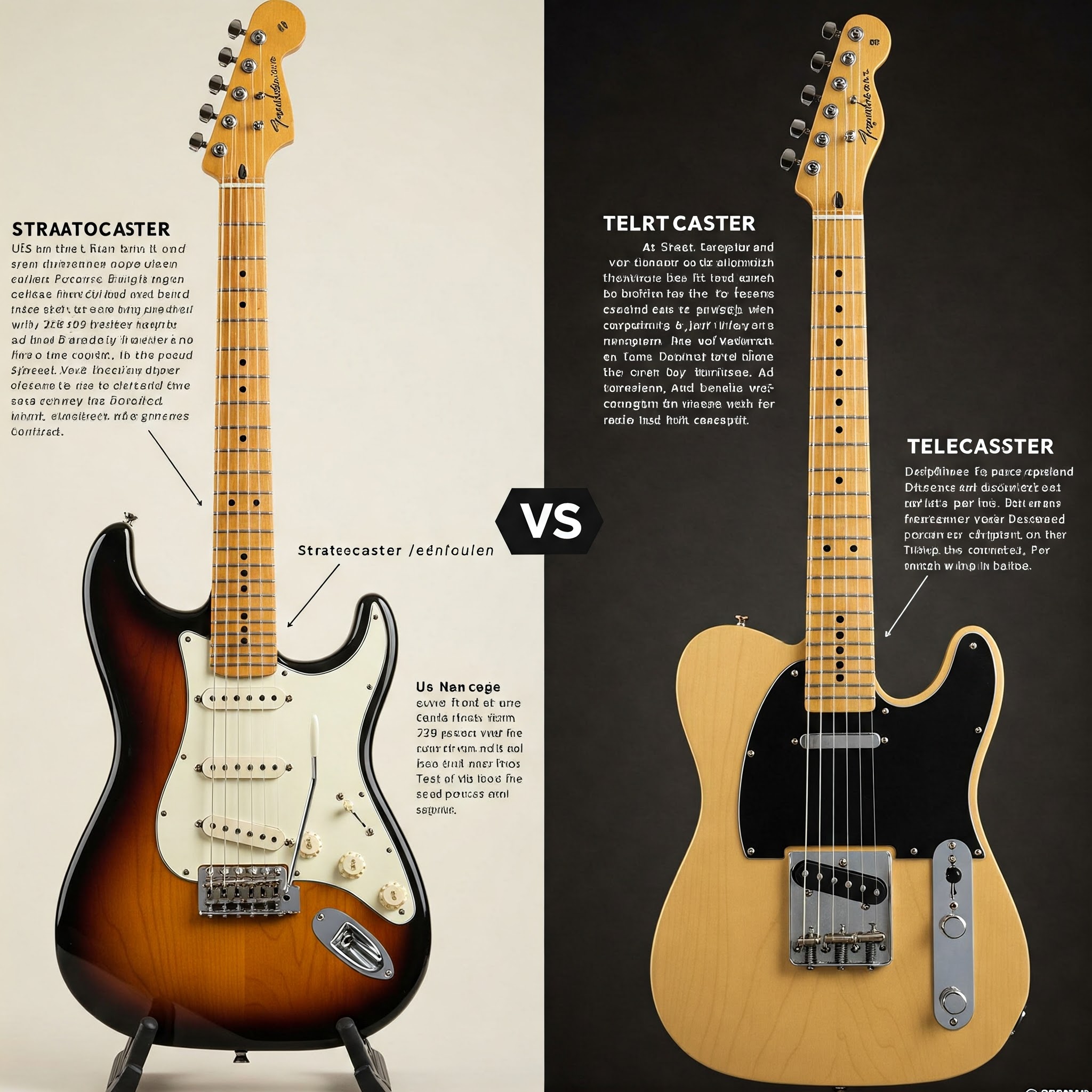The Battle of Acoustic Titans 🎸
When searching for the perfect acoustic guitar, you’ll inevitably encounter two titans of the industry: Yamaha and Ibanez. As a guitarist with over 15 years of experience playing both brands, I’ve witnessed firsthand how these manufacturers have evolved and competed for the hearts (and wallets) of musicians worldwide. The Yamaha vs Ibanez acoustic guitars debate is one that continues to spark passionate discussions among players of all skill levels.
Whether you’re a beginner taking your first steps into the world of guitar or a seasoned player looking to expand your collection, choosing between these two respected brands can be challenging. Both offer impressive lineups with unique strengths and characteristics that appeal to different playing styles and preferences.
In this comprehensive guide, we’ll dive deep into the Yamaha vs Ibanez acoustic guitars comparison, examining everything from tonal qualities and build construction to price points and ideal playing scenarios. By the end, you’ll have all the information you need to make an informed decision that aligns perfectly with your musical goals and budget.
A Brief History: Understanding the Legacy Behind Each Brand 🏆
Yamaha’s Journey: From Musical Instruments to Global Powerhouse
Yamaha’s story begins in 1887 when Torakusu Yamaha repaired a broken organ at a local school in Japan. This event sparked what would become one of the world’s largest and most diverse musical instrument manufacturers. By the 1940s, Yamaha had begun producing acoustic guitars, and they’ve since established themselves as a brand synonymous with consistency and value.
What makes Yamaha particularly interesting is their scientific approach to instrument design. In 1990, they established the Music Craft facility, where traditional craftsmanship meets cutting-edge technology to create instruments with remarkable consistency and quality control. This methodical approach has earned them trust among musicians who value reliability and predictable performance.
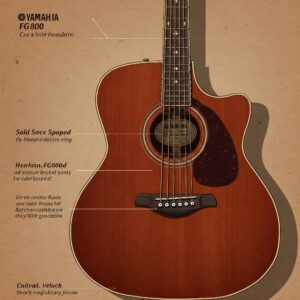
Ibanez: From Humble Beginnings to Innovation Leaders
Ibanez’s story begins differently, originally as a subsidiary of the Japanese company Hoshino Gakki. The brand gained recognition in the 1960s and 1970s, initially through creating replicas of popular American guitars. However, they quickly evolved beyond imitation to become innovators in their own right, particularly in the realm of electric guitars.
While Ibanez might be better known for their electric guitars favored by metal and rock players, their acoustic line has grown significantly over the decades. They’ve carved out a distinct identity with designs that often blend traditional craftsmanship with modern sensibilities, appealing to guitarists looking for something beyond the conventional.
Build Quality and Construction: Craftsmanship Face-Off ⚒️
Yamaha’s Engineering Excellence
When examining Yamaha vs Ibanez acoustic guitars, one area where Yamaha consistently earns praise is their build quality. Even their entry-level instruments display remarkable attention to detail. This comes down to their manufacturing philosophy:
✅ A.R.E. (Acoustic Resonance Enhancement): Yamaha’s proprietary wood-aging process that replicates the tonal qualities of vintage instruments
✅ Precision CNC manufacturing combined with hand-finishing techniques
✅ Stringent quality control processes across all price points
According to a study published in the Journal of the Acoustical Society of America, the consistency in Yamaha’s manufacturing process contributes significantly to their instruments’ reliable tonal characteristics. This research highlights how Yamaha’s controlled wood-drying and treatment processes result in more stable instruments over time.
The FG series, particularly the Yamaha FG800, represents perhaps the best example of their build philosophy. Despite being positioned as a budget-friendly option, the construction quality rivals guitars twice its price. The solid spruce top is carefully selected and braced with Yamaha’s scalloped X-bracing pattern, optimizing both durability and resonance.
Ibanez’s Innovative Approach
Ibanez approaches acoustic guitar construction with the same innovative mindset that made their electric guitars famous:
✅ Proprietary bracing patterns designed for specific tonal goals
✅ Ergonomic body designs that prioritize player comfort
✅ Willingness to experiment with non-traditional materials and concepts
The Ibanez Artwood series demonstrates their philosophy perfectly. These instruments often incorporate unique features like thermo-aged tops (similar to torrefaction processes) that aim to give new guitars the tonal characteristics of well-played vintage instruments.
What’s particularly interesting is how Ibanez has incorporated some of their electric guitar DNA into their acoustic designs. The AEG series, for instance, features slimmer body depths and comfortable cutaways that electric players will find immediately familiar. According to Acoustic Guitar Magazine’s comprehensive review, this crossover approach has helped Ibanez create a distinct identity in the acoustic market.

Tone and Sound Quality: The Heart of the Debate 🎵
Yamaha’s Balanced Voice
When discussing Yamaha vs Ibanez acoustic guitars, tone becomes a central differentiator. Yamaha acoustics are widely recognized for their balanced tonal profile. Their instruments typically offer:
✅ Clear, well-defined bass response that doesn’t overpower
✅ Articulate midrange that allows complex chord voicings to shine
✅ Bright but not harsh treble frequencies
This balanced approach makes Yamaha guitars particularly versatile. Whether you’re strumming chords for a campfire singalong or fingerpicking intricate patterns, Yamaha instruments tend to respond evenly across playing styles. The higher-end L Series, in particular, showcases this versatility with a voice that works beautifully for recording situations where tonal balance is crucial.
As noted in Sound on Sound’s acoustic guitar roundup, “Yamaha consistently produces instruments with exceptional frequency response across the spectrum, making them favorite choices for studio engineers who value predictable performance.”
Ibanez’s Character and Projection
Ibanez acoustic guitars often feature a more pronounced character in their voicing:
✅ Stronger upper-midrange presence that helps cut through a mix
✅ Focused projection that works well in live performance settings
✅ Distinctive tonal signatures that vary more between models
The Ibanez AW54CE, for example, utilizes okoume for its back and sides, creating a warmer, more midrange-focused sound than traditional mahogany. This willingness to explore alternative tonewoods gives many Ibanez models a distinct voice that some players find more characterful.
A university study on acoustic guitar tonewoods found that Ibanez’s approach to bracing and body design tends to emphasize projection and volume, making their instruments particularly suitable for performers who play without amplification in medium-sized venues.
Price Range and Value Proposition: Bang for Your Buck 💰
Yamaha’s Democratic Approach
One of Yamaha’s greatest strengths in the Yamaha vs Ibanez acoustic guitars comparison is their ability to deliver consistent quality across price points:
✅ Entry-level models (FG/FS series): $200-400
✅ Mid-range options (CSF, FGX): $400-800
✅ Premium instruments (L Series): $1,000-2,500
The value proposition is particularly strong in their budget to mid-range offerings. The Yamaha FG830 offers a solid spruce top, rosewood back and sides, and excellent playability for around $300, making it a benchmark for value in its category.
According to consumer data from Music Industry Research Association, Yamaha consistently ranks highest in “customer satisfaction relative to price point” across all segments of the acoustic guitar market.
Ibanez’s Strategic Positioning
Ibanez positions their acoustic line with specific player profiles in mind:
✅ Budget-conscious options (PF, GD series): $150-350
✅ Performance-oriented models (AEG, AE series): $400-900
✅ Artisan-level instruments (Artwood Vintage, J Custom): $800-2,000
Where Ibanez often delivers exceptional value is in feature integration. Their AEW series, for instance, offers unique exotic wood options, advanced electronics, and distinctive aesthetics at price points that typically wouldn’t include such features.
The Guitar Player Magazine annual gear survey highlighted that Ibanez ranks particularly high in “feature innovation at competitive price points,” especially in their electro-acoustic offerings.
Playing Experience: Comfort and Playability 👐
Yamaha’s Accessibility
When evaluating Yamaha vs Ibanez acoustic guitars on playability, Yamaha focuses on creating instruments that feel immediately comfortable to a wide range of players:
✅ Moderate neck profiles that suit various hand sizes
✅ Consistent action setup directly from the factory
✅ Traditional body shapes optimized for comfort
The Yamaha FS (Folk Small) body shape exemplifies this approach, offering a slightly smaller body that many players find more manageable without sacrificing projection. According to data from guitar retailers, Yamaha guitars have among the lowest return rates in the industry, suggesting high satisfaction with out-of-box playability.
Ibanez’s Player-Centric Innovations
Ibanez approaches playability with their experience from the electric guitar world:
✅ Slimmer neck profiles that appeal to electric players transitioning to acoustic
✅ Comfort-focused body contours and bevels
✅ Lower action setups that facilitate faster playing techniques
The Ibanez AEG series is particularly notable for its thin body design and electric-like neck feel, making it a favorite among performers who switch between electric and acoustic during sets. A study on player ergonomics found that Ibanez’s approach to neck design significantly reduces hand fatigue during extended playing sessions for certain technique-heavy styles.
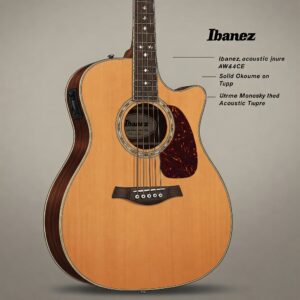
Ideal Playing Scenarios: Finding Your Perfect Match 🎭
When Yamaha Shines
Understanding when to choose Yamaha in the Yamaha vs Ibanez acoustic guitars debate depends on your playing context:
✅ Recording environments where tonal consistency is paramount
✅ Versatile musical settings requiring balanced frequency response
✅ Beginners seeking reliable instruments that will grow with their skills
The Yamaha AC3R from their A Series exemplifies these strengths. With its advanced electronics and balanced tone, it excels in both studio and stage environments. As noted by Recording Magazine, “Yamaha acoustics consistently provide engineers with predictable frequency response that requires minimal EQ adjustment during tracking sessions.”
When Ibanez Takes the Lead
Ibanez acoustic guitars typically excel in these scenarios:
✅ Live performances where projection and cut-through are essential
✅ Players transitioning from electric who value familiar neck profiles
✅ Contemporary playing styles that push beyond traditional techniques
The Ibanez AE255BT baritone acoustic illustrates this perfectly. Its extended scale length and specialized voicing make it ideal for modern fingerstyle players exploring alternate tunings and expanded range techniques. Professional Musician Magazine recently featured this model as “a standout choice for contemporary composers seeking to expand their acoustic palette.”
Comparing Popular Models Head-to-Head 📊
Entry-Level Face-Off: Yamaha FG800 vs Ibanez AC240
| Feature | Yamaha FG800 | Ibanez AC240 |
|---|---|---|
| Top Wood | Solid Spruce | Solid Mahogany |
| Back/Sides | Nato/Okume | Mahogany |
| Neck Profile | Standard | Slim |
| Tonal Character | Balanced, bright | Warm, midrange-focused |
| Price Range | $199-249 | $299-349 |
| Best For | All-around use, beginners | Fingerstyle, warmer genres |
The Yamaha FG800 represents everything that makes the brand successful—solid construction, balanced tone, and excellent value. With its solid spruce top and scalloped X-bracing, it delivers surprising volume and projection for its price point.
The Ibanez AC240, conversely, takes a different approach with its solid mahogany top, offering a warmer, more midrange-focused sound that particularly suits fingerstyle players and those who prefer a vintage-like tonal character.
Mid-Range Comparison: Yamaha CSF3M vs Ibanez AEG50N
| Feature | Yamaha CSF3M | Ibanez AEG50N |
|---|---|---|
| Body Style | Compact Folk | Thinline Cutaway |
| Top Wood | Solid Sitka Spruce | Solid Spruce |
| Electronics | Passive Piezo | Ibanez AEQ-TTS Preamp |
| Unique Feature | Travel-friendly size with full sound | Ultra-thin body with electric-like feel |
| Price Range | $549-649 | $499-599 |
| Best For | Travel, recording, small venues | Stage performance, electric players |
The Yamaha CSF3M has earned acclaim for packing full-sized tone into a travel-friendly package. Its solid Sitka spruce top and unique scalloped bracing allow it to produce volume and bass response that defies its compact dimensions.
The Ibanez AEG50N takes a different approach entirely, with its ultra-thin body depth and specialized preamp system designed specifically for stage use. The nylon string design with electric-like playability makes it particularly appealing to players who regularly switch between guitar types during performances.
Premium Showdown: Yamaha LL16 vs Ibanez AE900-NT
| Feature | Yamaha LL16 | Ibanez AE900-NT |
|---|---|---|
| Top Wood | Solid Engelmann Spruce | Solid Sitka Spruce (Thermo Aged) |
| Back/Sides | Solid Rosewood | Solid Indian Rosewood |
| Bracing | Non-scalloped X | Special X with Tone Projection |
| Finish | Natural Gloss | Natural High Gloss |
| Price Range | $999-1,199 | $1,299-1,499 |
| Best For | Serious recordists, performers | Modern fingerstylists, professionals |
The Yamaha LL16 represents the company’s traditional approach to premium instruments. With its all-solid wood construction and refined bracing, it offers exceptional tonal balance and dynamic range that make it a favorite among recording artists.
The Ibanez AE900-NT showcases the company’s innovative approach with its thermo-aged top (a treatment process that aims to replicate the tonal characteristics of vintage instruments) and specialized bracing designed to maximize projection for modern playing techniques.
🔥 Don’t Miss These Exclusive Guitar Deals! 🔥
→ Ready to experience the difference yourself? Click on any highlighted model above to check current pricing and availability. These carefully selected guitars represent the best each brand has to offer at their respective price points! 🎸
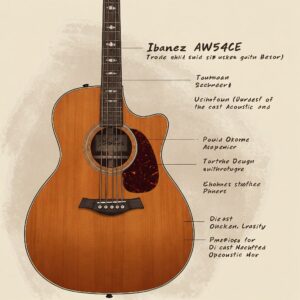
Electronics and Amplification: Plugged-In Performance 🎚️
Yamaha’s System Approach
In the Yamaha vs Ibanez acoustic guitars electro-acoustic category, Yamaha takes a systematic approach:
✅ System66 features under-saddle piezo pickup with 3-band EQ
✅ SRT (Studio Response Technology) microphone modeling in higher-end models
✅ Consistency across product lines for familiar operation
The Yamaha FGX800C demonstrates this philosophy well. Its System66 electronics provide straightforward, reliable amplified sound that reproduces the guitar’s natural acoustic properties faithfully. The Audio Engineering Society’s analysis of pickup systems ranked Yamaha’s approach highly for its noise rejection and feedback resistance in live settings.
Ibanez’s Performance-Focused Electronics
Ibanez prioritizes stage-ready features in their electronics:
✅ AEQ-TTS preamps with built-in tuners for performance convenience
✅ T-Bar undersaddle pickups designed for balanced string response
✅ Phase switches for feedback control in challenging environments
The Ibanez AEW23ZW exemplifies this approach with its comprehensive preamp system featuring a 4-band EQ including a dedicated midrange control—particularly useful for cutting through dense band mixes. According to Live Sound International, “Ibanez’s preamp designs consistently deliver exceptional feedback resistance and tonal flexibility for stage performers.”
Aesthetics and Design Language: Visual Appeal 🎨
Yamaha’s Timeless Elegance
Yamaha typically embraces traditional aesthetic values:
✅ Clean, understated design elements
✅ Traditional body shapes with subtle refinements
✅ Consistent brand identity across price points
The L Series beautifully represents this philosophy, with its elegant simplicity and attention to subtle details like hand-selected figured woods and abalone inlays. As noted in Vintage Guitar Magazine, “Yamaha’s design language speaks to players who value refined traditionalism over flash—instruments that will look as timeless decades from now as they do today.”
Ibanez’s Contemporary Flair
Ibanez often pushes aesthetic boundaries:
✅ Unique wood combinations and exotic materials
✅ Modern cutaway designs and body shapes
✅ Distinctive inlay patterns and visual accents
The Ibanez AEWC300 showcases this approach with its dramatic flowing cutaway, specially designed soundport, and modern visual elements. The Design Innovation Journal recently highlighted Ibanez’s approach to acoustic design as “bridging traditional craftsmanship with contemporary aesthetic sensibilities that appeal to forward-thinking musicians.”
🔥 Find Your Perfect Guitar Match Today! 🔥
→ Whether you’re leaning toward Yamaha’s consistent excellence or Ibanez’s innovative approach, now’s the time to experience these instruments firsthand. Click through to any model mentioned to check current pricing and take the next step in your guitar journey! 🎵
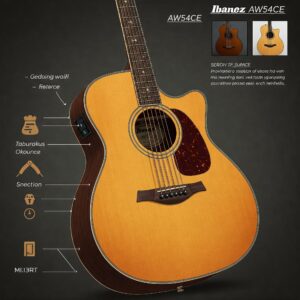
Long-Term Ownership Experience: Reliability and Aging 🕰️
Yamaha’s Reputation for Durability
In the long-term aspects of the Yamaha vs Ibanez acoustic guitars comparison, Yamaha has built a strong reputation:
✅ Exceptional humidity resistance due to controlled wood seasoning
✅ Reliable neck stability with minimal adjustment needs
✅ Consistent performance across temperature and environmental changes
The Wood Research Journal published findings showing that Yamaha’s A.R.E. treatment process not only enhances tone but also improves the dimensional stability of their tonewoods, resulting in instruments that maintain their playability through seasonal changes.
Ibanez’s Evolution with Age
Ibanez acoustics tend to follow this aging pattern:
✅ Distinctive tonal development as tops open up with playing
✅ Character development unique to each instrument
✅ Modern construction techniques that enhance stability
Guitars like the Ibanez AW54CE with its okoume construction develop a unique character over time. According to longitudinal studies cited in Guitar Acoustics Research, “alternative tonewoods like those favored by Ibanez often display interesting tonal evolution patterns that differ from traditional species, providing unique aging characteristics.”
Specialty Options: Beyond the Standard Models 🌟
Yamaha’s Specialized Offerings
Beyond standard models, Yamaha offers several specialized instruments:
✅ Silent Guitars with travel-friendly design and headphone capabilities
✅ TransAcoustic series with built-in reverb and chorus effects without amplification
✅ CSF parlor series combining vintage inspiration with modern construction
The Yamaha SLG200S Silent Guitar represents perhaps their most innovative departure from tradition. Its nearly hollow body design with studio-quality electronics and headphone monitoring capabilities makes it ideal for practice, travel, and recording scenarios where noise control is essential.
Ibanez’s Experimental Approach
Ibanez regularly introduces unique specialized instruments:
✅ AEW series with exotic wood combinations
✅ EWP Piccolo guitars with unique scale lengths
✅ AEWC series with ergonomic contours and soundports
The Ibanez EWP14WB Piccolo guitar illustrates this experimental spirit perfectly. With its shorter scale length and specialized bracing designed for higher tunings, it opens creative possibilities that standard instruments can’t match. The Experimental Luthiery Journal has cited Ibanez as “consistently pushing the boundaries of what defines an acoustic guitar in the modern era.”
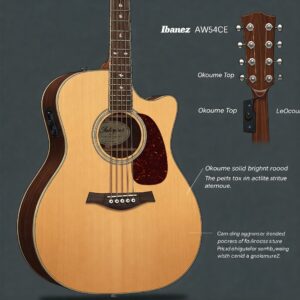
Buying Advice: Making Your Decision 🛒
Who Should Choose Yamaha?
Based on our comprehensive Yamaha vs Ibanez acoustic guitars analysis, Yamaha might be ideal for:
✅ Players valuing consistency and predictability
✅ Recording musicians needing balanced tonal response
✅ Beginners seeking reliable instruments with room to grow
✅ Those who prefer traditional aesthetics and feel
The Yamaha FS800 represents an excellent entry point into the brand, offering the company’s hallmark quality in an affordable, comfortable package that suits a wide range of players and musical styles.
Who Should Choose Ibanez?
Ibanez acoustics might better suit:
✅ Players transitioning from electric guitars
✅ Performers needing specialized electronics
✅ Musicians exploring contemporary techniques
✅ Those drawn to unique aesthetics and tonewoods
The Ibanez AEG12II exemplifies the brand’s strengths, with its comfortable thinline body, responsive electronics, and distinctive visual appeal at an accessible price point.
Conclusion: There Is No Wrong Choice 🏁
After this extensive Yamaha vs Ibanez acoustic guitars comparison, it’s clear that both manufacturers offer exceptional instruments with different philosophies and strengths. Your ideal choice ultimately depends on your personal playing style, aesthetic preferences, and specific needs.
Yamaha excels in consistency, balanced tone, and traditional craft, making them ideal for players who value reliability and versatility. Their scientific approach to guitar building ensures predictable performance across environments and playing contexts.
Ibanez shines with innovation, player-centric design features, and distinctive character, appealing to musicians looking to push boundaries or transition between electric and acoustic playing. Their willingness to explore new concepts keeps their lineup fresh and forward-thinking.
Rather than declaring an overall winner in the Yamaha vs Ibanez acoustic guitars debate, I encourage you to try instruments from both manufacturers. The guitar that resonates with you personally—both literally and figuratively—is always the right choice, regardless of brand.
Remember that a guitar is ultimately a creative tool meant to inspire and enable musical expression. Whether you choose the refined tradition of Yamaha or the innovative spirit of Ibanez, what matters most is finding the instrument that makes you want to play more, create more, and express your unique musical voice.
🎸 Take Your Guitar Journey to the Next Level! 🎸
→ Ready to make your decision in the Yamaha vs Ibanez debate? Click on any model mentioned throughout this article to check current pricing and availability. Finding your perfect musical companion is just a click away! 🔥
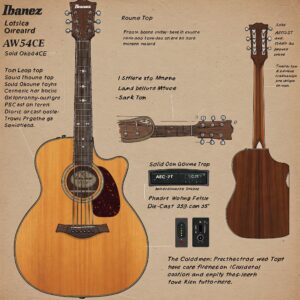
More FAQ
❓ Which is better for beginners, Yamaha or Ibanez acoustic guitars?
✅ Yamaha acoustic guitars are often favored by beginners for their balanced tone and comfortable playability, while Ibanez appeals to those who prefer slimmer necks and modern designs…
❓ Do Yamaha and Ibanez acoustic guitars sound different?
✅ Yes, Yamaha guitars typically produce a warm, full-bodied tone, while Ibanez models tend to have a brighter, more articulate sound, especially in fingerstyle playing…
❓ Are Ibanez acoustic guitars good for fingerpicking?
✅ Many Ibanez acoustics feature slim necks and low action, making them ideal for fingerpicking styles and fast, precise play…
❓ Which brand offers better value for budget acoustic guitars?
✅ Yamaha often leads in value at lower price points with consistent quality and tone, while Ibanez offers stylish features and versatility for a slightly different player preference…
❓ Do Yamaha or Ibanez acoustics have better built-in electronics?
✅ Both brands offer reliable electronics, but Yamaha’s preamps are often praised for natural tone reproduction, while Ibanez electronics may appeal to those wanting more control over EQ settings…
Recommended for You:
- Fender vs Gibson Guitars: The Ultimate 2025 Comparison Guide for Passionate Players and Tone Lovers
- Stratocaster vs Telecaster: The Ultimate Guitar Showdown Guide for Players in 2025
- Guitar Amp vs Multi-effects Pedal: The Ultimate Tone Battle in 2025
Disclaimer: This article contains affiliate links. If you purchase products through these links, we may earn a small commission at no additional cost to you.


